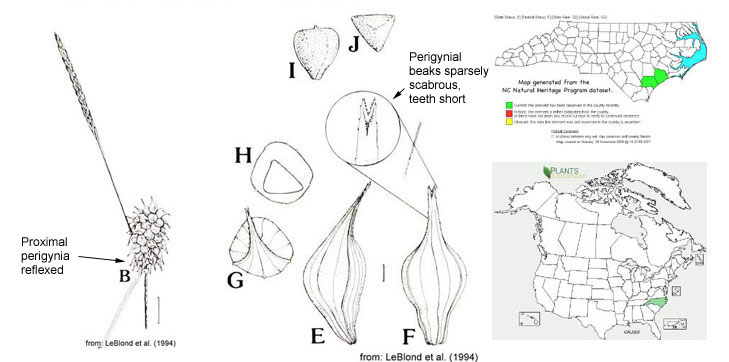Carex L. (Cyperaceae)
Carex (Cyperaceae) is represented by over 150 species in North Carolina. A number of species are of conservation concern, state listed or proposed for listing, but only Carex lutea is currently federally listed (Fed E, S2 G2). Those listed as endangered at the state level include: C. argyrantha (State E, S1 G5), C. basiantha (State E, S1 G5), C. exilis (State E, S2 G5), C. meadii (State E, S1 G4G5), C. oligosperma (State E, S1 G5), C. tenax (State E, S1 G5?), C. trisperma (State E, S1 G5), C. utriculata (State E, S1 G5), and C. vesicaria (State E, S1 G5). Numerous additional species are listed as threatened or special-concern vulnerable. For an update-to-date list, see the NC Plant Conservation Program.
Federally listed taxon—
Carex lutea (Fed E, State E | S2 G2)
Habitat. Ecotone between pine savanna and adjacent wet hardwood (often with Taxodium ascendens and Thalictrum cooleyi) in mildly acidic to circumneutral, wet to periodically inundated, sandy soils, frequently over coquina limestone.
Range. Endemic to the Coastal Plain of the southeastern US.
Additional resources. NHP | Recovery plan
Key to Carex lutea
Key adapted from LeBlond et al. (1994 [protologue, Sida]), Ball and Reznicek (2002 [FNA]), Crins (2002 [FNA]), and Weakley (2008). Photos by Krings, unless otherwise indicated. Line drawings from LeBlond et al. (1994). Maps courtesy of USDA PLANTS and the North Carolina Natural Heritage Program.
1. Perigynium beak teeth ≥ 0.5 mm long...[various spp.]
1’. Perigynium beak teeth typically < 0.5 mm long...2.
2. Perigynia minutely papillose...[various spp.]
2’. Perigynia smooth...3.
3. Terminal spike gynecandrous (i.e., pistillate flowers borne above the staminate in the same spike)...[various spp.]
3’. Terminal spike staminate or androgynous (i.e., staminate flowers borne above the pistillate in the same spike)...4.
4. Sheaths and blades pubescent...[various spp.]
4’. Sheaths and blades glabrous...5.
5’. Bracts with blades...6.
6. Style persistent...[various spp.]
6’. Style deciduous...7.
7. Young leaf blades (at least the widest) M-shaped in cross-section, adaxial surface with two marginal veins more prominent than the midvein...[various spp.]
7’. Young leaf blades V-shaped in cross-section; adaxial surface lacking two marginal veins more prominent than the midvein...8.
8. Proximal perigynia (lowermost on spike) ascending or spreading-ascending at maturity...[various spp.]
8’. Proximal perigynia in each spike reflexed at maturity...C. lutea* 


Habitat of Carex lutea (Photo: Krings)

Habit of Carex lutea (Photo: Krings)

Carex lutea (Photo: Krings)

Pistillate spike of Carex lutea (Photo: Krings)

Pistillate spikes of Carex lutea (Photo: Krings)

Pistilllate spikes Carex lutea (Photo: Krings)

Pistillate spike of Carex lutea (Photo: Krings)
Carex lutea*
(rare [Fed E, S2 G2]; wet savannas, shallowly over coquina limestone; CP; late spring to early summer)

